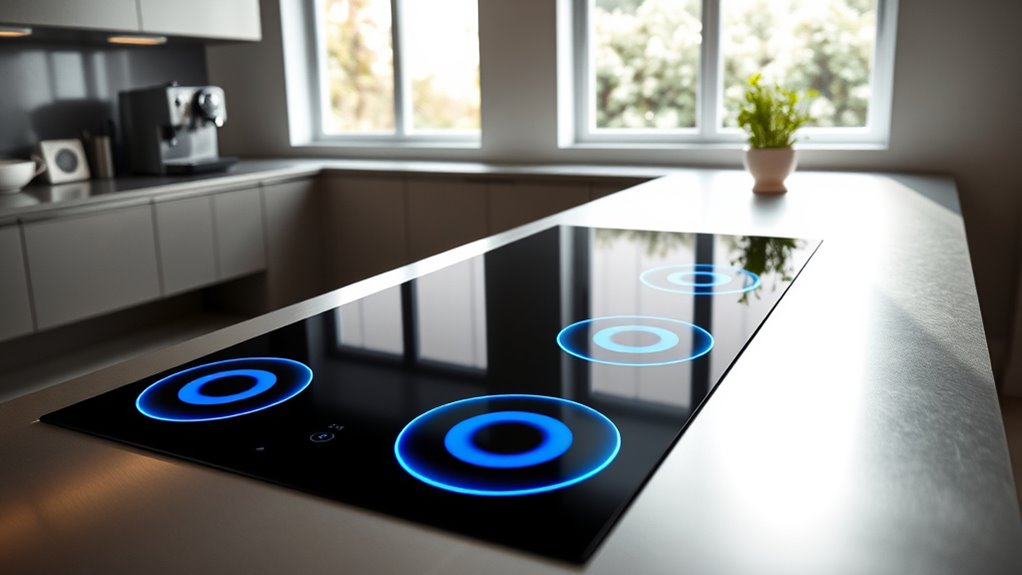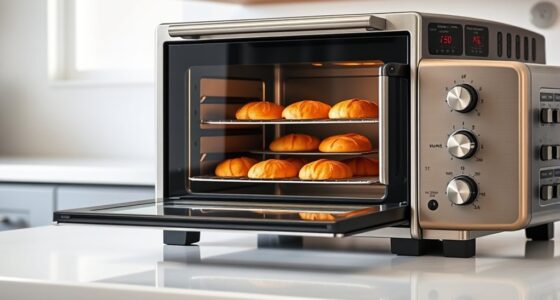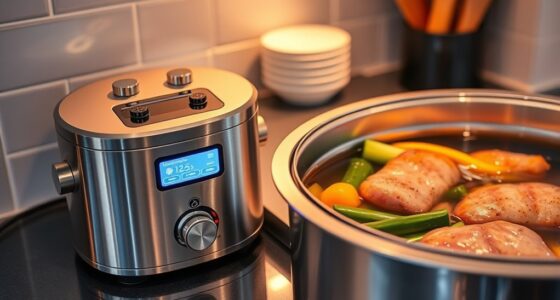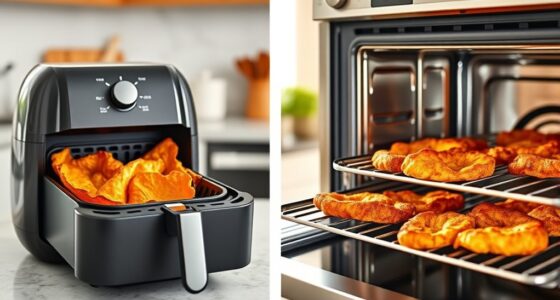Induction cooktops are transforming modern kitchens because they’re highly energy-efficient, offering faster cooking and lower utility bills. They include advanced safety features like spill detection, auto shut-off, and overheat protection, making them safer than traditional stoves. Their sleek, space-saving designs suit contemporary aesthetics, and their smart controls provide precise temperature management. As more households adopt these innovations globally, you’ll discover how induction is shaping the future of kitchens if you continue exploring.
Key Takeaways
- High energy efficiency transfers 84-90% of energy directly to cookware, reducing waste and lowering utility bills.
- Advanced safety features like overheat protection and spill detection make induction cooktops safer than traditional stoves.
- Sleek, modern designs with seamless surfaces and modular options integrate seamlessly into contemporary kitchens.
- Faster cooking times and precise temperature control improve efficiency and reduce food waste.
- Growing market adoption driven by urbanization, technological innovations, and sustainability concerns.
Rising Popularity Due to Energy Efficiency and Sustainability

Induction cooktops are gaining popularity because they offer superior energy efficiency and promote sustainability. They transfer about 84% to 90% of energy directly to your cookware, much higher than gas (40-60%) or traditional electric (74-79%). This direct energy transfer reduces heat loss to the air, making cooking faster and more efficient—boiling water in under 6 seconds compared to over 8 seconds on gas. The cooktops adjust heat to match the pan size, minimizing wasted energy. This efficiency lowers your electricity bills while reducing overall energy consumption. Additionally, induction cooking avoids burning fossil fuels indoors, cutting emissions and indoor air pollution. Its environmentally friendly design supports long-term sustainability goals by decreasing greenhouse gases and easing strain on energy infrastructure. Energy transfer efficiency is a key factor contributing to their rapid adoption in contemporary kitchens.
Technological Innovations Enhancing User Experience

Advancements in smart interfaces and interactive controls have transformed how you operate induction cooktops, making them more intuitive and user-friendly. Instead of basic touch buttons, you now get advanced displays with easy-to-navigate graphics, automatic cooking programs, and voice assistant compatibility for hands-free control. You can receive real-time alerts and manage your cooktop remotely via smartphone apps, thanks to Wi-Fi and Bluetooth connectivity. These features let you adjust temperatures, set timers, and monitor cooking progress from anywhere, freeing up your time. Sensors detect cookware presence, size, and temperature, ensuring precise energy use and safety. They also prevent messes with spill detection and optimize cooking results by dynamically adjusting heat. Induction technology is expected to dominate 2025, making cooking faster, safer, and more enjoyable. Additionally, the integration of advanced sensor technology enhances safety features and energy efficiency, further solidifying induction cooktops’ position in modern kitchens.
Safety Features Making Induction Cooktops a Preferred Choice
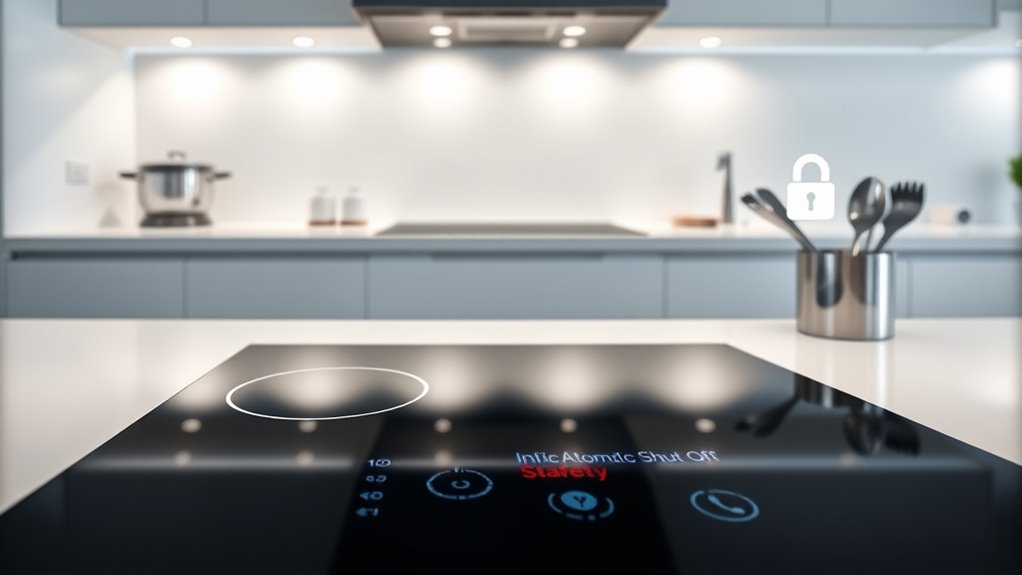
The safety features integrated into induction cooktops make them a popular choice for modern kitchens. First, intelligent pan detection ensures heat only activates when a suitable pan is present, stopping immediately when removed—reducing burn and fire risks. Second, overheat protection constantly monitors surface temperatures and automatically shuts off if limits are exceeded, preventing damage and kitchen fires. Third, the absence of open flames and combustion eliminates gas leak hazards and reduces the risk of burns and carbon monoxide poisoning. These features collectively make induction cooktops safer, especially for households with children or the elderly. Additionally, their rapid cooling surfaces minimize residual burns and facilitate quick cleaning, offering both safety and convenience in your everyday cooking. Auto shut-off and overheat protection further enhance safety by turning off the appliance if it remains idle or overheats, providing peace of mind during unattended cooking. Incorporating safety sensors can further prevent accidents by detecting unsafe conditions early.
The Shift Toward Modular and Modern Kitchen Designs
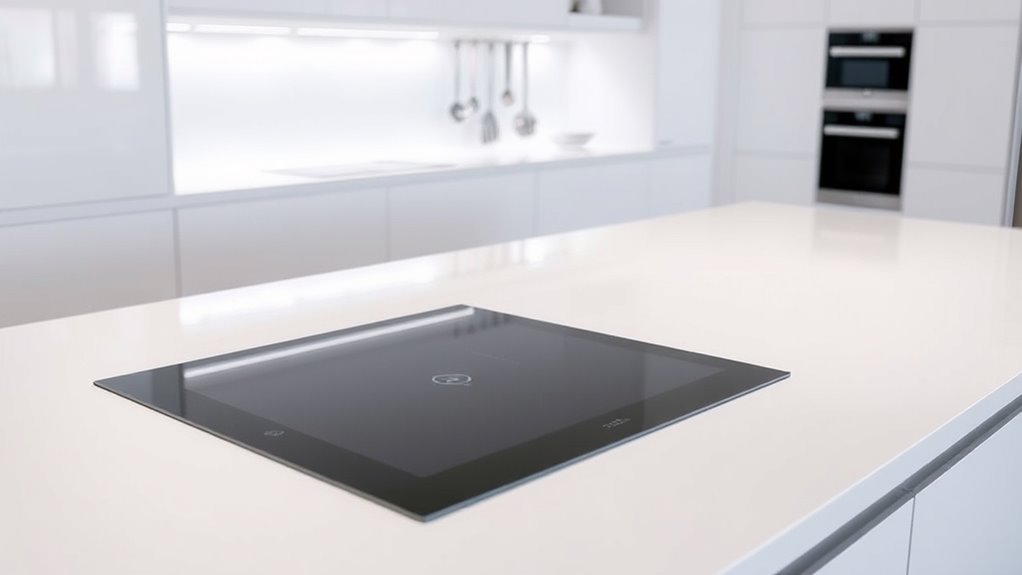
Modern kitchen designs prioritize sleek, space-saving layouts that maximize functionality without sacrificing style. Integrated appliances, like induction cooktops, fit seamlessly into these setups, making installation and maintenance effortless. As you explore these trends, you’ll notice how flexibility and clean aesthetics are reshaping how we cook and live. Retro-inspired elements such as vintage fixtures and bold color accents are also increasingly incorporated, adding warmth and personality to contemporary spaces. Incorporating modern appliance technology further enhances the efficiency and streamlined appearance of these kitchens.
Sleek, Space-Saving Layouts
As kitchen designs move toward greater efficiency and aesthetics, sleek, space-saving layouts have become essential. Modular components allow you to customize your kitchen, making the most of smaller or urban spaces. Integrated induction cooktops fit flush within islands, creating clean, uninterrupted surfaces. Plus, these layouts encourage multifunctionality, such as combining cooking zones with seating or storage. Here are three key benefits:
- Compact modular designs streamline workflows, reducing unnecessary movement.
- Flat, seamless surfaces from induction cooktops make cleaning easier and enhance minimalist appeal.
- Flexible arrangements allow quick updates and appliance replacements, ensuring your kitchen stays adaptable over time.
Research indicates that induction cooktops are increasingly favored for their safety and energy efficiency. This approach not only maximizes space but also maintains a modern, sophisticated look that suits contemporary lifestyles. Additionally, efficient general ledger coding can support the financial management of modern kitchen renovations by providing accurate budgeting and expense tracking.
Integrated Appliance Designs
Integrated appliance designs are transforming kitchens by creating a sleek, seamless look that blends functionality with aesthetics. Built-in appliances align with cabinetry, offering a flush, clutter-free appearance. Panel-ready options hide appliances behind custom panels matching your cabinets, while concealed hinges and adjustable toe-kicks support smooth integration without sacrificing usability. This approach highlights bold materials like stone or wood, making appliances a subtle backdrop. Modular configurations further enhance flexibility, allowing you to customize and reposition appliances to fit your space and needs. Smart, connected devices streamline cooking and boost efficiency. Appliance garages conceal small appliances, maintaining a clean surface. Sustainability remains key, with ENERGY STAR-certified options reducing energy use. This integrated approach elevates modern kitchens with sophistication and personalization. Cookies are used to enhance user experience and enable personalized features, aligning with modern kitchen trends.
Cost Savings and Environmental Impact in the Long Run
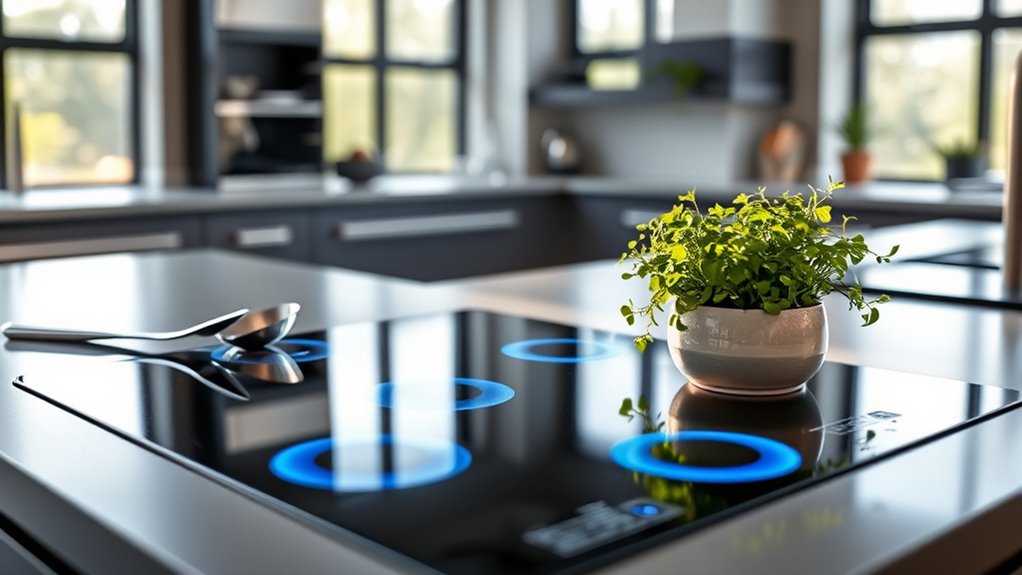
Induction cooktops offer significant long-term savings both financially and environmentally. You’ll see lower utility bills thanks to their high energy efficiency, converting about 84-90% of energy into heat—much more than gas or traditional electric stoves. Faster cooking reduces overall energy consumption, saving you money over time. Additionally, their precise temperature control cuts food waste and minimizes repairs. Induction cooking technology uses electromagnetic energy directly transferred to compatible cookware, ensuring minimal heat loss and further enhancing efficiency.
Induction cooktops save money and energy with fast, precise cooking and long-lasting, eco-friendly performance.
Consider these benefits:
- Reduced energy bills due to higher efficiency and faster cook times.
- Lower environmental impact by decreasing carbon footprint and emissions.
- Decreased operational costs from longer-lasting appliances and easier cleaning.
Expanding Market Reach in Emerging Economies

As urban populations grow rapidly in emerging economies, more households seek modern, energy-efficient cooking solutions like induction cooktops. Affordable prices and innovative features make these appliances increasingly accessible, especially as infrastructure improves. Supporting developments, such as better distribution networks, will be vital to expanding your market reach in these regions. Market growth projections indicate a strong upward trend in adoption rates, driven by increasing consumer demand for sustainable and convenient cooking options. Additionally, growing awareness of energy efficiency benefits will likely accelerate adoption further.
Rising Urbanization Trends
Rising urbanization in emerging economies is opening new opportunities for market expansion, especially in sectors like household appliances. As cities grow faster—1.6 times the global average—you gain access to larger, more dynamic consumer bases. Countries like India and Southeast Asia are leading the way with rising incomes and expanding middle classes, pushing urban households earning over $20,000 PPP beyond those in developed regions by 2025. This creates a lucrative environment for innovative products. Additionally, urban infrastructure investments, such as improved electricity access and smart city initiatives, support increased adoption of appliances like induction cooktops. Urbanization is also linked to increased demand for energy-efficient appliances, further driving market growth. Here are three key points:
- Rapid city growth boosts potential customer bases.
- Rising incomes increase discretionary spending.
- Digital transformation facilitates product penetration.
Furthermore, urban infrastructure development plays a crucial role in enabling the widespread adoption of innovative appliances like induction cooktops.
Affordability and Innovation
The affordability of induction cooktops is accelerating their adoption across emerging economies, driven by competitive pricing and technological advancements. Manufacturers in Asia-Pacific now offer advanced models at lower costs, making them accessible to price-sensitive markets like India and China. As prices drop, more households can upgrade from traditional stoves, fueling market growth. The table below highlights key factors influencing this trend:
| Market Growth | Technological Innovations | Regional Adoption |
|---|---|---|
| USD 26.9B in 2025 | Smart features, energy efficiency | China, India, S. Korea |
| CAGR 6.2–10.8% | Precise control, safety tech | Latin America, Africa |
| Supply chain improvements | Compact, aesthetic designs | Urban, middle-income consumers |
| Cost reductions via mass production | Automatic shutoff | Government incentives |
Furthermore, power efficiency plays a crucial role in attracting consumers seeking cost-effective and environmentally friendly cooking options.
Infrastructure Development Support
How does infrastructure development fuel the expansion of the induction cooktop market in emerging economies? It improves electricity access, supports urban growth, and enhances distribution channels, making induction cooktops more accessible. Expanding electricity infrastructure and household electrification, especially in China, boost electric cooking adoption. Additionally, government initiatives aimed at increasing rural electrification are reducing the urban-rural gap in appliance adoption. Urbanization, with multi-story homes and modular kitchens, creates demand for space-saving appliances. Growth of e-commerce and retail networks enables wider distribution, reaching tier 2 and 3 cities efficiently. These developments ensure reliable power, easier availability, and increased awareness, making induction cooktops a practical choice for modern households. As infrastructure continues to evolve, more consumers in emerging economies will adopt these efficient, safe, and innovative kitchen solutions.
Overcoming Barriers to Adoption and Future Growth Opportunities

Overcoming barriers to adoption requires addressing cost concerns, raising awareness, and enhancing technological features. High upfront costs for induction cooktops, along with the need for compatible cookware and possible electrical upgrades, can deter potential buyers. Promoting financing options, discounts, and incentives can make these appliances more accessible. Education is essential—many consumers lack awareness of induction’s benefits like faster heating and energy efficiency, while misconceptions about safety exist. Clear marketing, demonstrations, and training can boost confidence. Technological advancements, such as smart controls, connectivity, and safety features, improve usability and appeal. Expanding distribution channels and developing affordable models in emerging markets will accelerate growth. The market is also supported by a rising trend toward less oil and fat cooking methods, aligning with health-conscious consumer preferences. Additionally, increasing consumer familiarity through educational campaigns can significantly influence adoption rates. By tackling these barriers, induction cooktops can achieve broader acceptance and reshape modern kitchens worldwide.
Frequently Asked Questions
How Do Induction Cooktops Compare in Durability to Traditional Stoves?
Induction cooktops generally last longer than traditional stoves. You’ll find they have a lifespan of 10 to 15 years with proper care, thanks to their durable glass-ceramic surface and electromagnetic heating technology that reduces wear. Unlike traditional models, they resist cracking and scratching better, and their sealed surfaces make cleaning easier. By following maintenance guidelines and using compatible cookware, you can maximize their durability and enjoy reliable performance for years.
Are Induction Cooktops Compatible With All Types of Cookware?
Induction cooktops aren’t compatible with all cookware. You need magnetic or ferromagnetic materials like magnetic stainless steel, cast iron, or enameled iron for them to function. Non-magnetic pans like aluminum, copper, glass, or ceramic won’t heat unless they have a magnetic base. To check, use a magnet—if it sticks, your cookware should work. Always look for induction symbols or labels to guarantee compatibility before cooking.
What Are the Main Maintenance Requirements for Induction Cooktops?
You need to keep your induction cooktop clean and well-maintained for maximum performance. Wipe spills immediately with a soft, damp cloth and mild soap, and always let it cool before cleaning. Avoid abrasive materials that could scratch the surface. Regularly clean vents and fans, and use cookware with flat bottoms to prevent damage. Following these simple steps ensures your cooktop stays in great shape and lasts longer.
How Do Induction Cooktops Perform During Power Outages?
During a power outage, your induction cooktop‘s sleek surface goes dark, like a silent stage. Without electricity, it won’t work unless you’ve set up a backup like a battery or generator. You might use a portable gas stove or solar oven instead. Keep in mind, induction is highly efficient and safe, but for outages, having a backup guarantees you can still cook, making your kitchen resilient and ready for anything.
Can Induction Technology Be Integrated Into Existing Smart Home Systems?
You can integrate induction technology into your existing smart home systems by choosing models compatible with platforms like Google Home or Amazon Alexa. These cooktops often support apps for remote control, monitoring, and automation. Just make certain your Wi-Fi connection is reliable and keep firmware updated. Some models may require additional modules or sensors, but overall, smart induction cooktops easily connect, giving you hands-free control and seamless integration into your smart home ecosystem.
Conclusion
As you consider upgrading your kitchen, you’ll find that induction cooktops are becoming increasingly popular—growing at a CAGR of over 8% globally. Their energy efficiency, safety features, and sleek design make them a smart choice for modern homes. With technological innovations and expanding markets, induction cooktops are poised to dominate the future of cooking spaces. Embrace the change and enjoy a more efficient, safe, and stylish kitchen experience.
